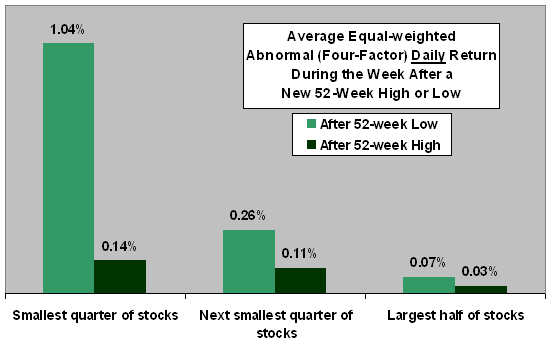Do 52-week highs and lows trigger unusual trading and returns for individual stocks? In their recent paper entitled “Volume and Price Patterns Around a Stock’s 52-Week Highs and Lows: Theory and Evidence”, Steven Huddart, Mark Lang and Michelle Yetman examine the evidence that past price extremes influence trading decisions, with focus on 52-week highs and lows. Using weekly volume and closing prices for a random sample of 2,000 stocks listed for at least a year during November 1982 through December 2006 (24 years), they conclude that:
- Stocks are above their 52-week highs (below their 52-week lows) 13.4% (9.1%) of the time.
- Volume spikes when stock price crosses above (below) the 52-week high (low), then gradually subsides. The spike is more pronounced:
- The longer the time since price last achieved the extreme;
- The smaller the firm;
- The higher the individual investor interest in the stock;
- The greater the ambiguity regarding valuation of the stock; and,
- The higher the aggregate market sentiment.
- Small-investor trades are predominantly buyer-initiated after 52-week highs and 52-week lows.
- Driven by results for small stocks, both raw and risk-adjusted (for market, size, book-to-market and momentum) average returns for equal-weighted portfolios of stocks crossing 52-week extremes are reliably positive over the next week and month. Specifically:
- After 52-week lows (highs), the average abnormal return for the smallest quarter of stocks is about 5% (0.6%) over the next week. See the chart below.
- Average abnormal one-month returns are smaller.
- Overall, results are consistent with attention-skewed investor behavior.
The following chart, constructed from data in the paper, shows average daily abnormal (four-factor) returns for equal-weighted portfolios of stocks during the week after the stocks make new 52-week highs or lows. There are six portfolios, three each segmented by market capitalization for stocks making 52-week lows and stocks making 52-week highs. The most dramatic average abnormal returns occur for the smallest quarter of stocks after 52-week lows.

In summary, traders may be able to exploit systematic one-week reversals in the prices of small stocks making 52-week lows.